Table of contents:
Key takeaways:
- Webinar platforms streamline the entire webinar process. They help you run a webinar, including registration, promotion, live hosting, recording, and analytics.
- Built-in engagement tools (like polls, Q&A, chat, breakout rooms, and live reactions) significantly improve attendee participation and retention, which often leads to higher conversion rates.
- Video/recording quality is a major differentiator. Most tools stream at 1080p, but only a few offer higher-quality recording or multi-track/local capture. This matters for post-production and on-demand reuse.
- Editing is usually limited. Many platforms offer only trimming or light overlays; if you need real editing and repurposing, pick solutions with built-in tools, like Riverside.
- Pricing varies widely depending on audience size, automation features, branding options, and the quality of video streaming and recordings. It’s best to match software selection to your actual webinar goals.
Creating webinars is no easy task, even if you’re experienced. Not only do you have to organize your content and guests, you also have to manage the technical setup.
Fortunately, many of the best webinar tools out there make this work faster and easier. Sounds good, right? Here’s our list of top webinar software in 2025 for you to try.
18 best webinar software platforms
Looking for the best software to help you get your next webinar up and running? Here are our top picks.
Note:
- Most platforms have various pricing tiers. The one displayed here is the entry level price for webinar features. Available features will vary by plan.
- While most platforms have a maximum number of attendees, some are able to expand those limits for enterprise-level clients. This is shown on the chart with a “+.”
- Maximum stream quality refers to the video quality viewers will experience. Most platforms stream at 1080p because it’s more reliable and accessible than 4K for live audiences.
- Multi-track recording refers to recording each participant on a separate track for easier, higher-quality editing.
- Built-in editing tools allow you to polish your video to show it on demand or repurpose it into other content. You can edit out bloopers, add an intro and outro, clean up audio, and add captions for a more professional video.
Riverside: Best overall webinar software
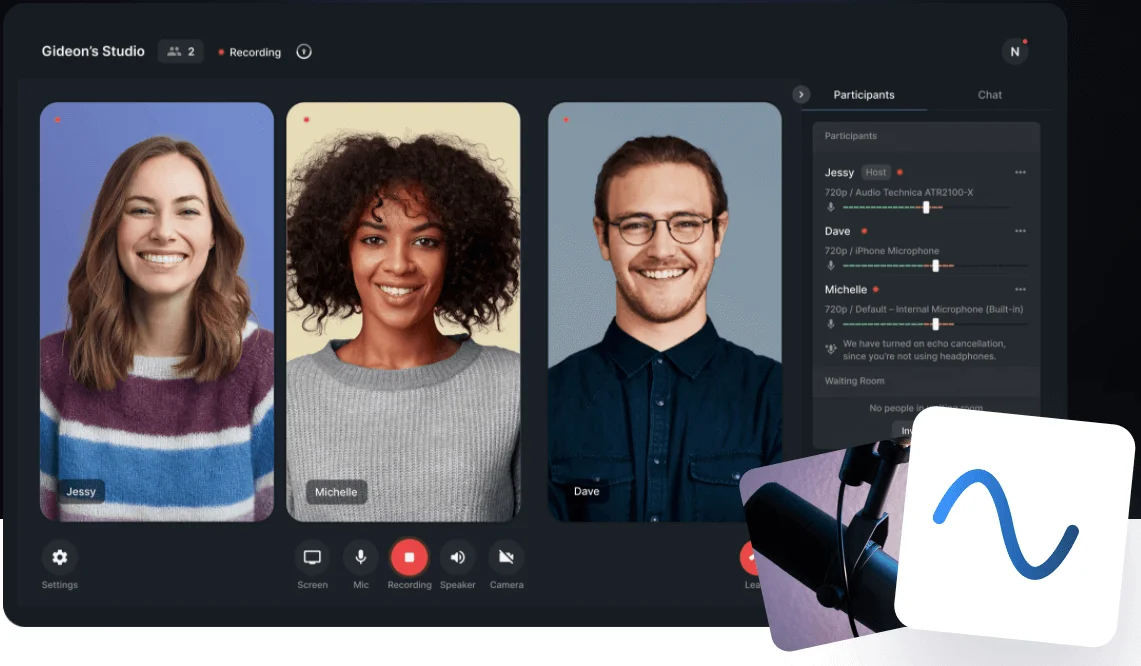
Price: Starts at $79/month.
Max attendees: 10,000.
In addition to being an excellent webinar hosting tool, Riverside is an all-in-one platform where you can plan, stream/record, edit, and repurpose your content. With Riverside, you can create customizable registration forms, sync registrant data to HubSpot, and get analytics on webinar registration, attendance, and engagement.
What I love most about Riverside (and one of its biggest distinctions in the comparison table above) is its high-quality recordings. You’ll get super-crisp audio and video, making your webinar look extra professional from the get-go. Then, you can use Riverside’s convenient editing tools to polish your audio, add captions and branding, and create a video you’ll be proud of.
Or even better, you can prompt Co-creator, your new AI editing agent, to turn your webinar recording into endless assets in minutes.
Key features
- Livestream in HD quality with up to 10 speakers and 10,000 viewers.
- Easy-to-use platform. Guests and participants can join with a link, no downloads or signups required.
- Record in up to 4K video and 48 kHz audio with separate tracks for easy editing.
- Schedule your webinar and send invites to participants (Riverside handles the reminders!).
- Easily share your screen or a presentation directly from Riverside (no fumbling with multiple tabs).
- Multistream to multiple social media platforms for a bigger audience.
- Upload your company logo and choose a matching background for on-point webinar branding.
- Engage participants with live chat, Q&A, and call-ins.
- Use the text-based editor and AI-powered Co-Creator to quickly repurpose your recording or polish it for on-demand viewing.
- Turn your webinar into promotional short clips for social with Magic Clips.
Pros:
- Best-in-class audio and video recording quality.
- AI features for faster editing and repurposing.
- User-friendly interface.
- Designed for remote guests.
Cons:
- Fewer audience engagement features than some other tools.
User review: “The live stream quality and stability are top-tier. I've hosted live conferences with hundreds of attendees and never experienced a dropped feed. The interface lets me monitor all speakers, trigger recordings, and handle technical issues discreetly using the producer controls.” — Viktoriao S., Virtual Event Manager
Zoom: Best for large-scale, live webinars
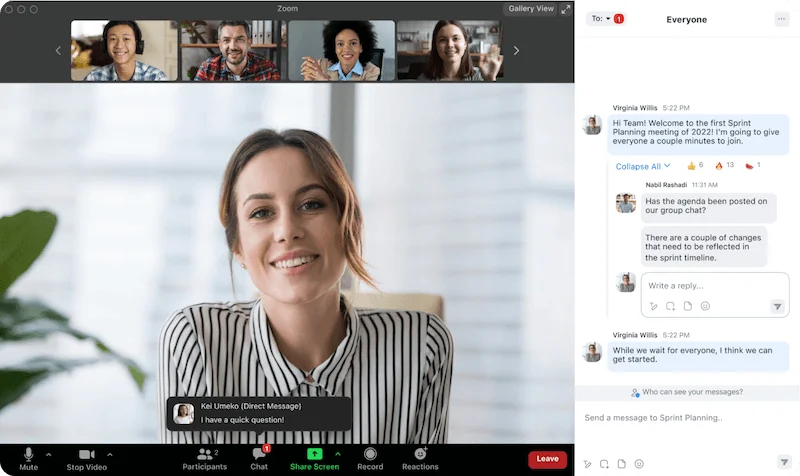
Price: Starting at $90/month.
Max attendees: 10,000+.
When it comes to webinars, Zoom is one of the best-known and most-used platforms out there. It’s built for real-time audience interaction and large-scale virtual events, and it offers the basic features you’ll need in an interface most people are already familiar with. It’s reliable for live webinars as well as recording, and includes branding options and integrations with CRMs to help you keep track of your audience.
Unfortunately, Zoom compresses its audio and video during recording, which can lead to lower-quality recordings and less flexibility when it comes to editing. But, Zoom does allow for 10,000+ webinar participants and is very stable as a live streaming platform, making it a good option for especially large live webinars.
Key features
- Customize registration fields to collect attendee details before they join.
- Enable chat, Q&A, polling, and raise-hand functionality for interaction.
- Record sessions to the cloud with automatic transcripts and make them available on demand.
- Manage roles and participation with host controls, such as muting, attendee promotion, waiting rooms, and security options.
- Allow participants to join from desktop or mobile from any device without downloading anything.
- Charge a registration fee through PayPal to support paid webinars.
Pros:
- Familiar interface can feel welcoming for attendees and guests.
- Scales to audiences of 10,000+.
- Built-in registration pages and automated reminders.
- Cloud recording makes for easy sharing and replays.
Cons:
- Lower audio and video recording quality.
- No separate tracks for remote guest audio.
- Advanced webinar features require paid add-ons.
- Requires third-party tools for editing and repurposing.
User review: What I like best about Zoom Events & Webinars is the professional-level control it gives organizers while still being user-friendly for attendees. One downside is that the backend interface can feel a bit clunky and overwhelming at times, especially when managing complex, multi-session events” — Tyler S., Mmarketing and Communications Specialist
WebinarNinja: Best for your first webinar

Price: Starting at $29/month.
Max attendees: 1,000+.
WebinarNinja is built for simplicity, making it an ideal choice when you need to get a webinar live fast. With pre-built templates and a guided step-by-step setup, you can launch in minutes, without digging through complex menus or settings.It includes tools for registration, email automation, interactive features like polls and Q&A, and analytics. The platform also supports live and pre-recorded sessions as well as automated replays.
What I like best about WebinarNinja is its pricing structure. It charges per attendee, which can make it really affordable for new or smaller webinars. Plus, unlike other providers, you get access to everything on one plan, with no higher-level features reserved for more expensive tiers.
Key features
- Create registration and thank-you pages using built-in customizable templates.
- Upload your slides directly to the platform and control everything from one place.
- Automate confirmations, reminders, and follow-up emails to keep attendees informed.
- Monitor registration, attendance, engagement, and conversions through analytics and reporting.
- Enable paid webinars and timed offers to support monetization.
- Integrate with email marketing tools, CRMs, and payment providers to streamline workflows.
Pros:
- Very easy to set up, even for non-technical users.
- Good value compared to some higher-priced platforms.
Cons:
- Lower-quality streaming/recording (720p).
- No built-in editing tools.
User review: “I love the simplicity of setting up a webinar — it only takes a few minutes. The built-in email automation, Q&A, and polls make it easy to engage my audience without needing extra tools.” — Daniel N., Marketing Consultant
Demio: Best for marketers focused on conversions
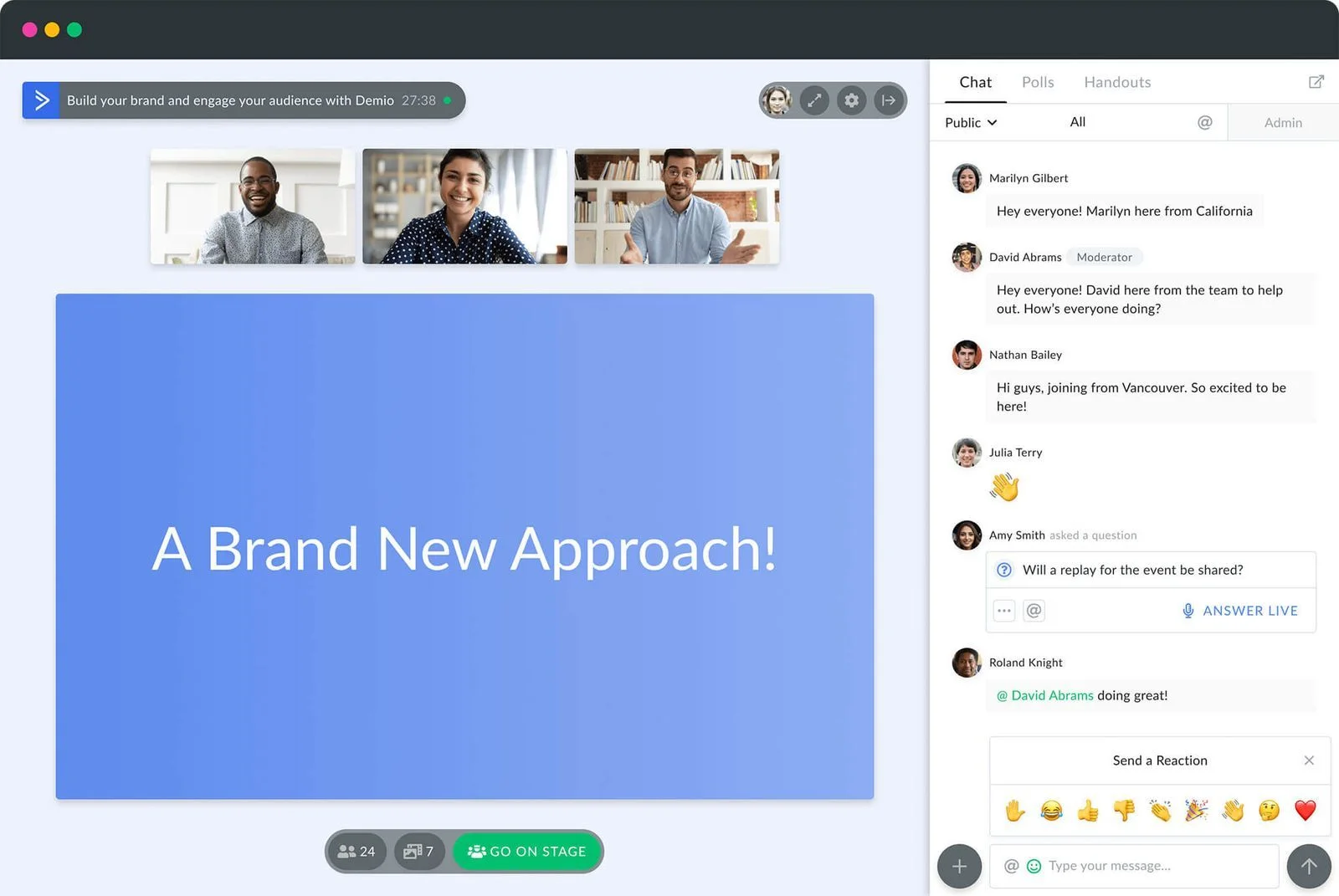
Price: Starts at $63/month.
Max attendees: 3,000.
Demio stands out because it is very focused on conversion and ROI. This web-based webinar platform supports both live and on-demand webinars with plenty of options for branding and customization.
But, analytics is where it really shines, providing detailed information on registrants and their behavior. This can help marketers better qualify leads and even measure the success of your webinar promotion.
Key features
- Provide attendees with interactive options, including chat, Q&A, polls, handouts, and clickable “Featured Actions.”
- Apply branding to registration pages and webinar rooms, with optional custom domains for a consistent brand presence.
- Analytics provides you with registration, attendance, and engagement metrics to assess and improve marketing performance.
- Connect with email marketing platforms, CRMs, payment systems, and other third-party tools through integrations.
Pros:
- Simple, user-friendly interface.
- Seamless registration, engagement, and follow-up features.
- Built-in leads capture and automation.
Cons:
- Gets very pricey with higher numbers of attendees.
- No audio/video editing.
User review: “The platform itself is excellent for hosting a webinar. You won't have the potential connectivity issues you'd have with other meeting platforms, the interactive elements keep attendees engaged, and you get really good post-webinar analytics. But the HubSpot integration is cumbersome. You have to set it up for every webinar..” — Jim H., CMO
Livestorm: Best for security and privacy
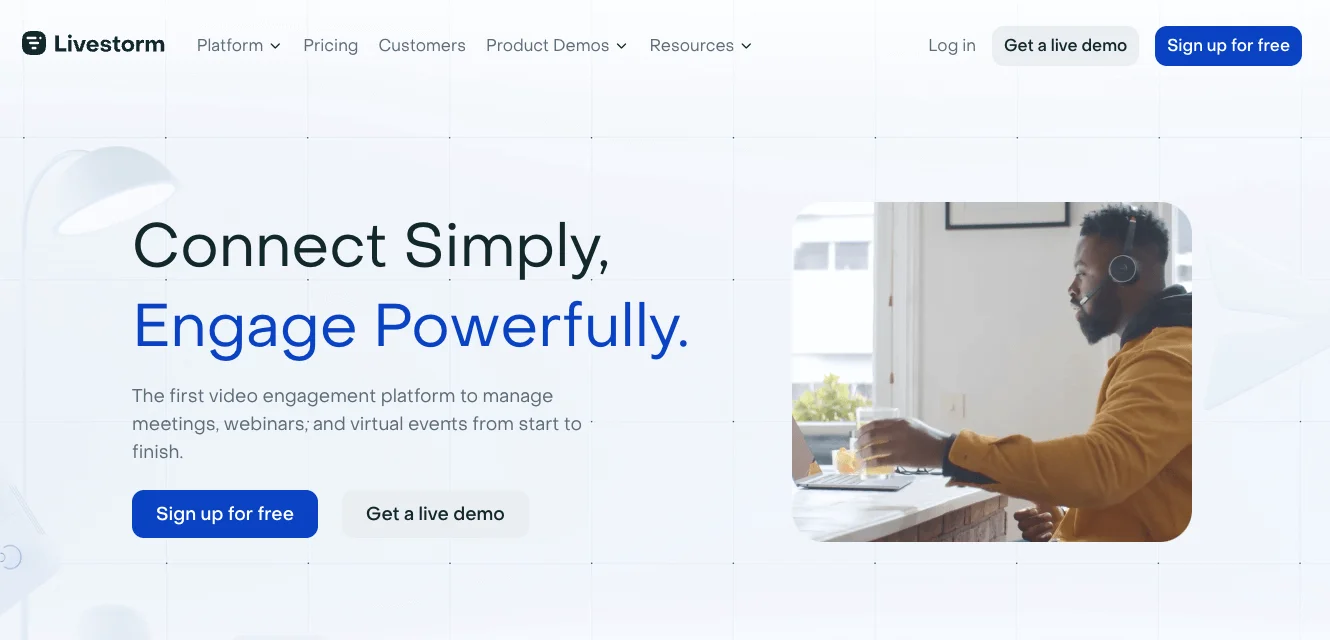
Price: Starts at $105/month.
Max attendees: 3,000.
Like some of the other options on this list, Livestorm is an all-in-one webinar and virtual event platform. It supports both live and on-demand events, is easy to use, and offers registration and analytics.
It’s a good overall pick, and marketers who are concerned about data security and privacy will appreciate that the company uses strict information security, risk management, and data protection controls (ISO 27001 certified), and is GDPR compliant by default.
Key features
- Allow attendees to join directly from their browser without installing software.
- Create customizable registration pages, automated email reminders, and embeddable signup widgets.
- Use engagement tools such as chat, Q&A, polls, hand raising, and media sharing during sessions.
- Stream webinars to platforms like LinkedIn, YouTube, and X through multistreaming options.
- Apply branding to registration pages, webinar rooms, and email communications.
Pros:
- Very easy to set up and use, with an intuitive UI for both hosts and attendees.
- Strong marketing and funnel features (registration, automated emails, integrations) in one platform.
Cons:
- Pricing based on yearly active contacts means price can scale quickly.
- Limited to 3,000 live attendees per session on all plans.
User review: “I got my first event organized in less than 15 minutes, complete with a registration page list, automatic reminder emails, and even my company logo. I was glad that I didn't have to install anything. The price could be a problem because even if it works great, the bill feels heavy when you start to handle a lot of guests.” — Pratik P., Project Manager
GoTo Webinar: Best for ‘simulated live’ webinars

Price: Starts at $49/month.
Max attendees: 3,000.
GoTo Webinar is known for its reliable performance and easy hosting experience, even for non-technical teams. It includes strong lead-generation tools, like customizable registration pages, source tracking, and automated reminders and follow-ups.
Its “recorded events” option lets you schedule a pre-recorded webinar that still supports live chat and Q&A, making it great for repeatable events. I also love the feature that allows you to draw right on the screen!
Key features
- Support live events for up to 3,000 attendees (with the ability to join by browser on supported devices).
- Build custom registration pages and forms with branding options for landing pages and email communications.
- Use engagement tools, such as polls, surveys, chat, Q&A, hand raising, and multi-presenter support.
- Track registration sources, attendance, and engagement with detailed analytics and reporting.
- Integrate with CRMs, email marketing systems, and automation tools.
- Store sessions with cloud recording.
- Generate automatic transcripts on recorded webinars.
Pros:
- Excellent reliability and scalability.
- Strong lead-generation workflows.
Cons:
- Editing capabilities are limited to a trimming tool.
- Pricing scales up quickly as capacity grows.
User review: “Very easy to join and navigate. Even as a first-time user, I joined the webinar without any setup headaches. As a guest speaker, I couldn’t personalize my display name or background as much as I wanted.” — Erika R., Mortgage Loan Officer
EasyWebinar: Best for marketers looking for full-funnel features

Price: Starts at $31/month.
Max attendees: 10,000
For those focused on their marketing funnels, EasyWebinar might be your best bet. It allows you to use webinars as a repeatable tool for conversions and lead generation.
You can run live events in HD with high-quality sound, which isn’t a guarantee on many other platforms. You can also stream pre-recorded sessions with the look, feel, and experience of a live event. What I like best is that there’s a lot you can customize in these sessions, including in-event CTAs. For those who want webinars that convert, this is really key.
Key features
- Host live webinars with HD streaming, co-hosts/guest presenters, screen sharing, chat, polls, and Q&A.
- Run automated or ‘simulated live’ webinars by scheduling pre-recorded videos that allow for live chat and timed interactions.
- Use engagement and conversion tools, such as timed CTAs, scarcity timers, polls, and attendee behavior tracking.
- Create registration pages, embed sign-up forms, send reminders, and integrate with CRMs and email automation platforms for marketing workflows.
- Stream to platforms like YouTube or LinkedIn, or connect via RTMP for broader reach.
Pros:
- Affordable plans that scale with the number of attendees.
- User-friendly interface with quick and intuitive setup.
- Excellent marketing-funnel conversion focus.
Cons:
- No editing or post-production tools.
User review: “I like the ease of use and setup. Pretty much once I have run one webinar, I can clone and setup multiple in a breeze. We have run close to 30 since we started running it this new year and it has been a game changer for our business. My only dislike is there can be some bugs at times that can be frustrating.” — Darrin B., Marketing Director
BigMarker: Best for large-scale, branded events
.webp)
Price: By request.
Max attendees: 500,000.
A lot of webinar platforms sell themselves based on simplicity, but BigMarker is all about customization. Yes, it has templates, but it also provides complete design control, including access to HTML, CSS, and JavaScript.
This allows you to build webinar experiences that are totally your own, whether you’re creating a simple registration page, or a full-featured microsite for your content. It also has a suite of monetization features, including the ability to sell tickets, host pay-to-view webinars, and embed registration payment.
Key features
- Engagement tools, including live chat, up-voted Q&A, polls, quizzes, and options to invite attendees on screen, share handouts, and connect with social platforms.
- Integrate with CRMs, marketing automation systems, and payment providers.
- Embed webinars into websites or apps.
- Support large-scale events with enterprise hosting options for audiences up to 500,000 attendees.
Pros:
- Strong customization and branding, with the ability to create a fully customized website.
- Full funnel support, from registration to live to follow-up.
- Reliable performance for large events.
Cons:
- Because it’s feature-rich, there’s a significant learning curve.
- Higher pricing.
User review: “I like that we can track everything our customers are doing within the webinar, and that once we create the webinar if we have it setup properly our team can run the webinars and we don't have to be there. I think the hardest part is all of the settings. ” — Cristina S., Customer Success Manager
ClickMeeting: Best for training, onboarding, and education
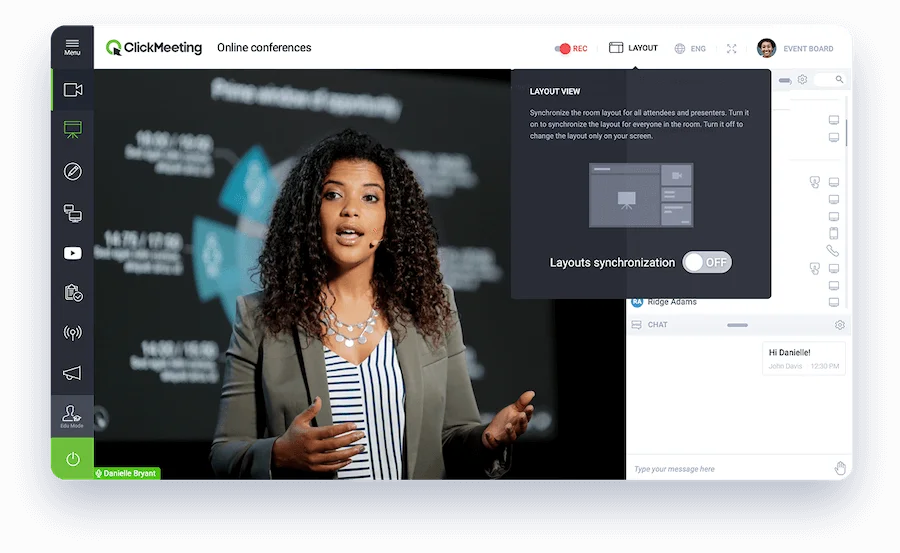
Price: Starts at $32/month.
Max attendees: 10,000.
You can do just about anything on this relatively affordable and easy-to-use platform. ClickMeeting allows you to create live, automated, and on-demand webinars, and provides lots of built-in monetization options that are great for professionals selling training or courses.
I like that you can easily record your webinar on this platform and get an automatically generated transcript. You can also stream live to up to 5 social media platforms and monetize your webinar with a paywall.
Key features
- Sell access to webinars using built-in payment options, including virtual tickets and paid recordings.
- Use engagement tools, such as polls, Q&A, chat, screen sharing, breakout rooms, whiteboards, and handouts for interactive sessions.
- Customize registration pages, automate reminders and follow-ups, and review analytics on attendee behavior and engagement.
- Host large webinars or virtual events with branding options and enterprise-level configurations for high-capacity audiences.
Pros:
- Very user-friendly and intuitive for hosts and attendees.
- Simple setup for monetization features.
Cons:
- No built-in editing tools.
- Webinar funnel features are less developed in lower-priced tiers.
User review: “ClickMeeting is very intuitive and reliable. It allows us to organize professional webinars and online events with ease. Some design and branding options could be more flexible, but overall it works very well.” — Program Inkubacyjny F., CEO
LiveWebinar: Best for creators, educators, and trainers
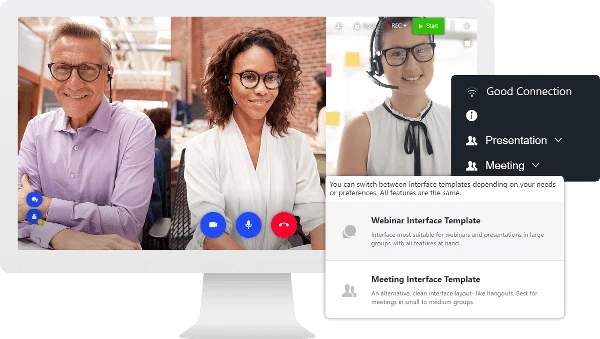
Price: Starts at $32/month.
Max attendees: 1,000.
LiveWebinar stands out for HD quality broadcasts and high-quality multistreaming, helping you look more polished and get the message out to more people.
You can embed webinars directly on your website (a perk for some creators). I also like the tools they have to drive participation and results, including polls and surveys, live chat, calls to action, and certificates you can provide to attendees.
Key features
- Allow attendees to join directly in the browser from any device, with no software installation required.
- Stream and record in HD with options for screen sharing and multiple presentation formats.
- Customize webinar rooms, use your own domain, and embed registration forms on your website.
- Charge for access using built-in paid webinar support.
Pros:
- Very easy to use.
- Good value for the features provided.
- Excellent customization and branding options.
Cons:
- Pricing rises quickly with number of users.
- Some users report video lag and glitches.
User review: “I primarily use LiveWebinar for realtime meetings — replacing Zoom about a year ago. There's no software to download and easy to use and manage. Sharing your screen or other content isn't quite as intuitive as Zoom, but definitely not difficult.” — Michael K., Owner and Marketing Coach
Webex: Best for enterprise organizations
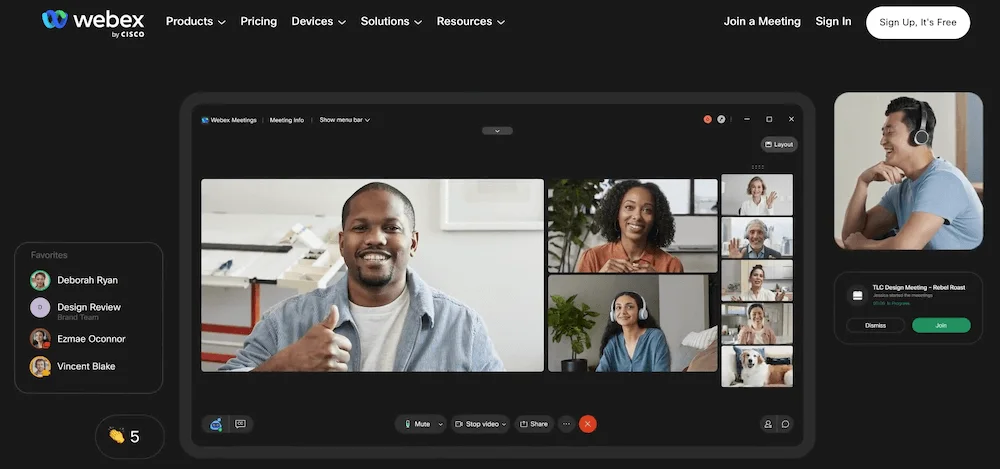
Price: Starts at $68.75/month.
Max attendees: 100,000.
Webex is especially popular in enterprise environments thanks to its reliability, strong security, privacy, and data protection, and its ability to host large audiences (up to 100,000 attendees).
It supports live, simulive, and on-demand streaming, and offers excellent options for custom branding.Key features
- Use engagement tools, such as chat, polls, Q&A, breakout rooms, and Slido (engagement tool) integration for advanced audience interaction.
- Run practice sessions and apply moderation controls to manage speakers and audience participation smoothly.
- Track registration, attendance, and engagement with analytics and integrate with CRMs and marketing automation tools.
- Provide accessibility and international support with real-time translation and closed captioning across multiple languages.
Pros:
- Enterprise-level reliability and scalability.
- Strong security and compliance (great for those working in regulated industries).
- Comprehensive features for branding, lead capture, attendee management.
Cons:
- For large attendee capacities and advanced features, pricing can be more expensive than simpler webinar tools.
- With many features and enterprise controls, there may be a steeper learning curve or more setup time compared to simpler platforms.
User review: “What I appreciate most about Webex is its consistently reliable video and audio quality, which holds up well even in lengthy meetings. Scheduling, joining, and sharing screens are all straightforward, and the chat and recording features help keep collaboration both smooth and well-organized. One thing I don't like about Webex is that it tends to use a lot of system resources, which can cause it to lag, especially when several people are sharing their screens or using video at the same time.” — Ruvimbo J., Associate
GetResponse: Best for teams focused on lead gen
.webp)
Price: Starts at $69/month.
Max attendees: 1,000.
GetResponse is an all-in-one digital marketing platform that includes a built-in webinar tool. This can be an advantage for those who already use GetResponse, as it’s integrated into this marketing stack.
With GetResponse, you can run live and on-demand webinars, use built-in registration pages, send email invites/reminders, and engage attendees with polls, Q&As, and whiteboards. You’ll only get up to 1,000 attendees here, though, so this is definitely for smaller businesses.
Key features
- Host unlimited webinars with customizable registration pages and landing pages.
- Convert live sessions into on-demand webinars for ongoing access.
- Use built-in marketing tools, including email invites, reminders, and Facebook Pixel integration for retargeting.
- Run and manage webinars from a mobile device using the dedicated app.
Pros:
- Integration with GetResponse’s marketing stack.
- Good feature set for standard webinars.
- Very easy and straightforward to use.
Cons:
- Limited attendee capacity.
- May provide more tools than you need.
Adobe Connect: Best for AI features
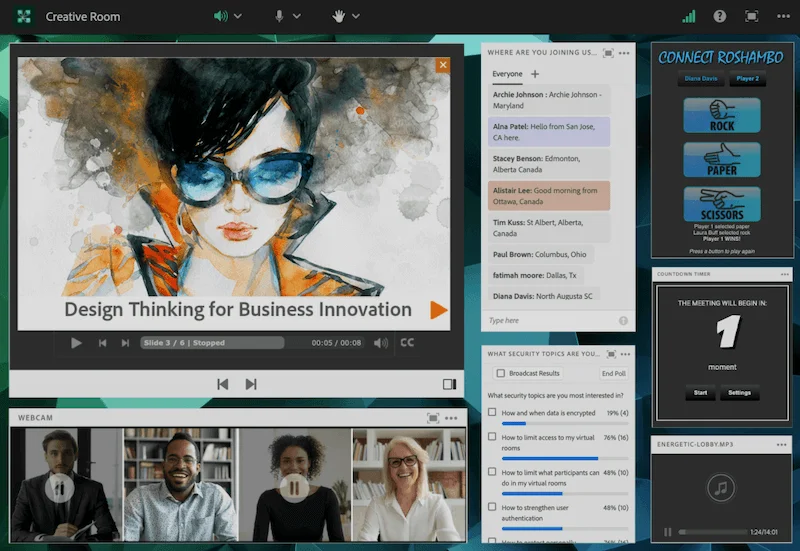
Price: Starts at $190/year.
Max attendees: 1,500.
Adobe Connect is a robust virtual meeting, training, and webinar platform designed for organizations that want deep customization and persistent virtual rooms. It supports live, on-demand, and simulated live formats, with lots of options for customization and engagement.
One selling point many people will appreciate: An AI assistant that helps presenters set up features and workflows. It can even automatically create blog content based on your webinars.
Key features
- Build customizable registration pages and forms to manage event sign-ups.
- Deliver pre-recorded content as simulated live webinars while still enabling chat, polls, and other interactions.
- Reuse virtual rooms with preset layouts, including breakout rooms, to streamline presenter setup.
- View real-time audience engagement indicators to adjust presentation delivery.
- Arrange “pods” such as slides, video, chat, polls, and file downloads to design a fully customized webinar layout; change it up on the fly so that engagement tools appear when and where they’re needed.
- Support accessibility and multi-language experiences with features like captions and multiple audio tracks.
Pros:
- Very high level of customization and control.
- Strong engagement tools.
- Great for training events where reusability and structured presenter workflows matter.
Cons:
- Steeper learning curve compared to simpler webinar tools.
- Pricing is higher than more basic webinar platforms.
WebinarGeek: Best for small- to mid-sized businesses

Price: Starts at $85/month.
Max attendees: 5,000.
WebinarGeek is a webinar platform aimed primarily at small- to medium-sized businesses and creators. It supports live, automated/evergreen webinars, registration workflows, and marketing-oriented features, with an emphasis on ease of use and professional branding.
For the price, WebinarGeek also has some cool higher-end features, including live captions and the ability to ‘localize’ your webinar and deliver it in different languages.
Key features
- Set up webinars quickly with simplified tools for customizing content and layouts.
- Manage audience outreach using registration, confirmation, and countdown pages, along with automated email reminders and follow-ups.
- Review attendee data and collect feedback through built-in evaluation forms.
- Use AI features, such as automated captions, late-joiner summaries, and performance insights to improve engagement and results.
Pros:
- Very intuitive and user-friendly interface.
- Good value for the features offered.
- Solid marketing/lead-gen style webinars with a built-in workflow that takes people through from registration to follow-up.
Cons:
- Customization of registration pages or deeper marketing automation is more limited than some larger platforms.
- Integration with CRMs or marketing stacks is limited on lower tier plans.
User review: “Overall, I found that the site is clear, and all features function smoothly. However, there are a large number of options available. For new users I think, this abundance can feel overwhelming.” — Kwan Y., Professional Freelancer
ON24: Best for customized B2B marketing

Price: By request.
Max attendees: 5,000.
ON24 is a high-end webinar and virtual event platform designed primarily for B2B marketing, enterprise webinars, and large-scale digital events. It positions itself as an “intelligent engagement platform” that transforms webinars into content assets, integrates with marketing/sales systems, and surfaces high-value audience insights.
What makes ON24 stand out is the level of customization it offers. Yes, you can customize design and landing pages, but you can also customize CTAs for each attendee. The platform also has some great AI features to help you repurpose your content and create nurture pages to convert no-shows.
Key features
- Offer live, simulive, and on-demand webinar formats.
- Use engagement options, such as Q&A, polls, surveys, chat, downloadable resources, breakout rooms, interactive CTAs, and customizable viewer consoles.
- Build content hubs to organize webinars, videos, and resources for ongoing audience engagement.
- Access advanced analytics and AI tools to track viewer behavior, generate transcripts and clips, and integrate insights with CRMs and marketing automation.
- Support large enterprise needs with high-capacity events, multilingual features, accessibility options, branding control, and tech-stack integrations.
Pros:
- Known to be reliable, which is excellent for scaling large webinars.
- Built for ROI, with registration funnels, conversions, analytics, and content repurposing.
- Strong brand and customization capabilities, so events feel professional and polished.
- Deep integration potential with CRMs/marketing tools.
Cons:
- Complex to set up and may require more training than simpler tools.
- Known for more expensive pricing.
User review: "I've been using the ON24 Webinar Platform for several months now for hosting client webinars and internal trainings. Overall, it's a solid platform with a professional interface and a great set of features for both presenters and attendees. But there’s a steep learning curve, especially when setting up events and configuring all the widgets.” — Emmanuel A., Advisor
Goldcast: Best for creating a webinar content engine

Price: Prices start at $10,000/year.
Max attendees: 10,000.
Goldcast is custom built for B2B. It’s a pretty slick interface, with lots of higher-level features, like automatic captions and overlays, polls, video Q&As, and GIFs.
It has good-looking and easy-to-use brandable templates, and the platform makes it easy to automate pre- and post-webinar sequences. It also has AI-driven repurposing tools to help you create social posts, blogs, and engaging on-demand videos.
Key features
- Build branded registration and landing pages without coding using customizable templates.
- Host live webinars or schedule pre-recorded sessions to run as simulive events.
- Track attendee behavior and connect webinar data to CRMs and marketing automation platforms for targeted follow-up.
- Set registration and attendee limits to manage event capacity.
Pros:
- Very strong branding and customization features.
- Excellent content lifecycle features to help extend ROI.
- Supports lead generation, conversion tracking, and integrated funnel workflows.
Cons:
- Higher pricing.
- More complex setup and integration.
User review: “The built-in studio and AI-powered content repurposing tools save us hours of post-event editing and marketing work. The UI is clean, and the ability to brand everything makes the experience feel high-end.” — Harshad P., Software Engineer
Sequel.io: Best for B2B
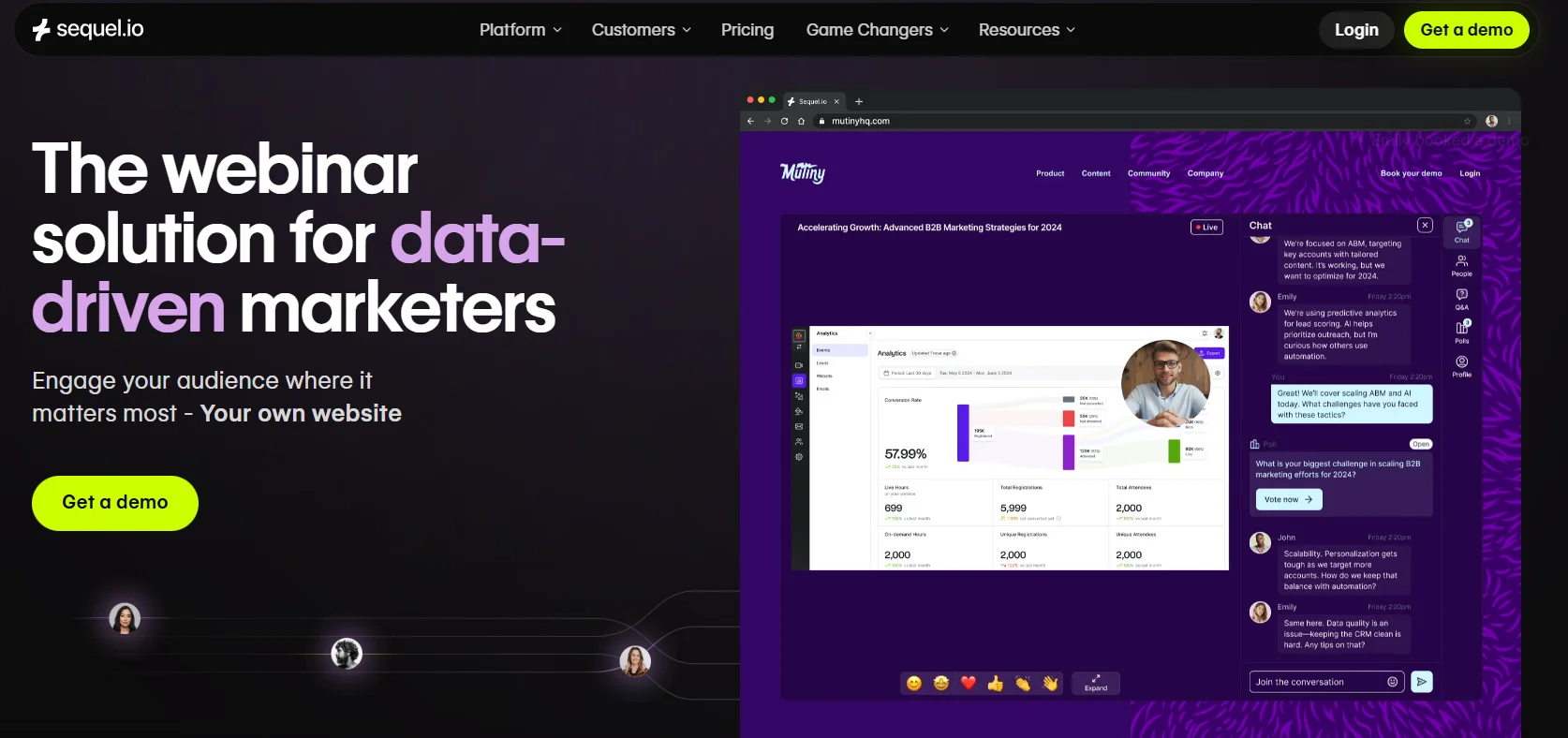
Price: Prices start at $950/month.
Max attendees: 2 million.
Sequel.io is a webinar and virtual-event platform for marketers, B2B teams, and website-first creators. It emphasizes embedding webinars directly on your website (rather than routing attendees off-site) and gives strong focus to branding, data/insights, and content repurposing.
It can also merge website tracking with webinars, for better reporting (which is pretty cool if you want to better understand the impact your webinars have on your domain).
Key features
- Embed webinars directly to your website so attendees stay on your domain for a consistent branded experience.
- Manage registration, bulk attendee uploads, email reminders, and follow-ups within the platform.
- Stream live with high-quality video and audio, and support media playlists and visual overlays.
- Organize webinar series or multi-session programs with a single registration flow.
- Capture first-party audience data and reduce drop-off by keeping the entire experience on your site.
Pros:
- Excellent brand experience and reporting/analytics.
- Good for webinar presented as a series.
- Solid features for registrations, live sessions, and embedding.
- High-quality local recording.
Cons:
- High cost for smaller teams.
- Limited editing tools.
User review: “Having webinars hosted directly on our website has been a game-changer. It’s seamless for attendees and drives much higher engagement. We did hit a few integration hiccups with our marketing automation software and had to set up some pre-webinar workarounds.” — Chris P., Director of Demand Generation
Wistia: Best for video-heavy business that care about custom branding

Price: Starts at $319/month.
Max attendees: 2,500.
Wistia is primarily a video marketing and hosting platform that features built-in webinar functionality. It lets you manage video content and host live or on-demand webinars from the same environment. This means you can treat your webinar as part of your broader video strategy (not just a standalone event).
Wistia is one of the few platforms that has reasonably good editing tools. It’s built not just to host live webinars, but to repurpose content for on-demand video and other assets.
Key features
- Host live webinars or virtual events directly in Wistia with browser-based access for attendees.
- Automatically save live streams as videos for editing and on-demand playback.
- Use interactive video features, like chapters, time-synced CTAs, and email capture to support marketing goals.
- Access detailed analytics, including viewer heatmaps, engagement graphs, and conversion tracking.
- Integrate with marketing tools and CRMs to sync contacts, track activity, and automate follow-up workflows.
- Customize the player with brand colors, thumbnails, and controls to deliver a consistent visual experience.
Pros:
- Good built-in editing and repurposing tools.
- Ability to embed the event on your website for better branding control.
Cons:
- Custom branding, marketing integrations, and automation are limited to higher-tier plans.
- Relatively low number of max attendees for the price.
User review: “I have been using Wistia for about 3 to 4 years, primarily for hosting educational videos on technology platforms with my company. I appreciate its easier integration and ad-free experience compared to YouTube. But I would prefer a cheaper pricing model for Wistia. Additionally, I wish Wistia offered more robust AI translation, transcription, and dubbing features similar to YouTube to enhance its utility.” — Joshua A., Verified G2 reviewer.
How to choose the best webinar software
Not sure how to choose from the 18 options above? Here are some tips on what to consider when you’re narrowing down your choices.
Ease of use
The more features a webinar software has, the steeper its learning curve will likely be (and the more it will cost). Here’s an important rule of thumb: Don’t get more features than you’re sure you’ll use. It’s also a good idea to try any software you’re considering first through a free trial or free plan.
Audience capacity and scalability
The maximum audience size a webinar platform supports is a major consideration, and the range is absolutely huge! The key is to choose a software that is within what you’ll need, but where you’ll also have room to grow. Also, look at breakpoints where additional attendees will bump you into a more expensive plan.
Branding and customization
Most webinar software offers some level of branding and customization. The exact amount of customization you need depends on your use case.
Also, consider who will do the work of building landing pages and running webinars, and how technical they are. Some webinar softwares offer simple templates you can customize, while others require more technical expertise.
Engagement tools
If you run live events, consider how you’ll engage your audience. Most webinar software offers different options, including live chat, Q&A, polls, breakout rooms, and CTAs. Not every webinar needs every feature, so let your goals determine what you need.
If your goal is:
- Lead generation: Prioritize polls, CTAs/offers, chat/Q&A, analytics and tracking, and mobile access.
- Training or education: Prioritize interactive whiteboards, screen sharing, quizzes/surveys, breakout rooms, and replay interaction.
- Large-audience, brand events: Prioritize attendee participation features (hand-raise, stage guests), performance/stability, decent chat/Q&A, and branding.
- =Evergreen/automated webinars: Prioritize on-demand interaction, CTA integration, analytics, and replay features.
Integrations
When you’re choosing webinar software, evaluate the integrations it supports. Integrations help you streamline workflows, automate marketing, and connect the webinar tool with your broader tech stack.
Good webinar software should, at a minimum, integrate with CRM systems and marketing automation/email platforms. Some people may also need integrations with payment systems and collaboration or productivity tools. Overall, consider what you’ll use and start there.
Analytics
Analytics provide visibility into how your webinars perform and can help you improve your marketing over time. When you’re comparing platforms, look for how they track data and what they collect.
If your webinars are for training or education, you’ll be more interested in behavior metrics. If your webinars are for lead gen or sales, you’ll be more interested in conversion tracking.
Video quality
Not all webinar platforms stream or record in high quality. For streaming, you’ll want a platform that supports 1080p. For recording, look for up to 4K.
Local recording on separate tracks will provide the best audio/video quality and will make editing easier, ensuring that you get the highest quality results. Riverside records in up to 4K video and 48 kHz audio and provides tools for easy multi-track editing, too!
Security and privacy
Your specific industry and geographic region influence how crucial security and privacy are for your brand. At a minimum, your chosen platform should encrypt streams and recordings, offer role-based permissions, and provide tools, like passwords, waiting rooms, and host-only screen sharing, to prevent unauthorized access.
It may also be important to understand how the platform handles attendee information, including data storage, consent options, and the ability to delete or export personal data. For organizations with compliance needs, check whether the platform supports requirements like GDPR, SOC 2, or ISO 27001 and allows data to be hosted in appropriate regions.
FAQs about webinar software
Can I host a webinar for free?
Yes, there are lots of options for hosting a webinar for free as long as you don’t plan to have a large number of attendees. Some webinar platforms that have modest free plans include:
- Livestorm: Offers a free plan with unlimited events, but it’s capped at 30 registrants and 20-minute sessions.
- Zoho Webinar: Has a free plan that supports up to 100 attendees.
- FreeConferenceCall: Offers free webinar hosting with screen sharing and video.
It’s also possible to host a webinar on virtual conference software, like Google Meet or Zoom. Just note that you’ll be more limited in terms of features and flexibility.
Can I host a webinar on Google Meet?
Yes, you can host a webinar on Google Meet, but it isn’t built specifically as a webinar platform, so there are trade-offs.
You can host up to 1,000 participants (depending on your plan), share slides/video, and use Q&A, polls, and the hand-raise feature for engagement. You can even record and save your webinar (again, depending on your plan.) But, you won’t get registration pages, branding, and analytics if you host your webinar on Google Meet.
Can I host a webinar on Microsoft Teams?
Yes, you can host a webinar on Microsoft Teams, especially if you’re using Microsoft 365 Business or Enterprise plans. Teams has specific webinar functionality to support more formal, large-audience events.
With teams, you can live stream to up to 10,000 viewers, engage them with Q&As, polls, and chats, and get an automatic recording and transcript. Where Teams is more limited is in branding options and production capabilities—there’s no local multi-track recording or studio-style layouts here.
Do people make money from webinars?
Yes, they do. There are a few ways to monetize a webinar. These include:
- Hosting a paid webinar: You can sell tickets for a live event or show on-demand content as pay-per-view.
- Driving sales/leads: You can sell subscriptions, courses, or digital/physical products as part of the webinar or follow-up.
- Sponsorship or brand partnerships: You can sell sponsored presentation slots or branded giveaways as part of your webinar.
- Affiliate revenue: You can promote partner products in the webinar or through follow-ups to earn a commission.







.webp)














.webp)

.webp)
-p-800.webp)



